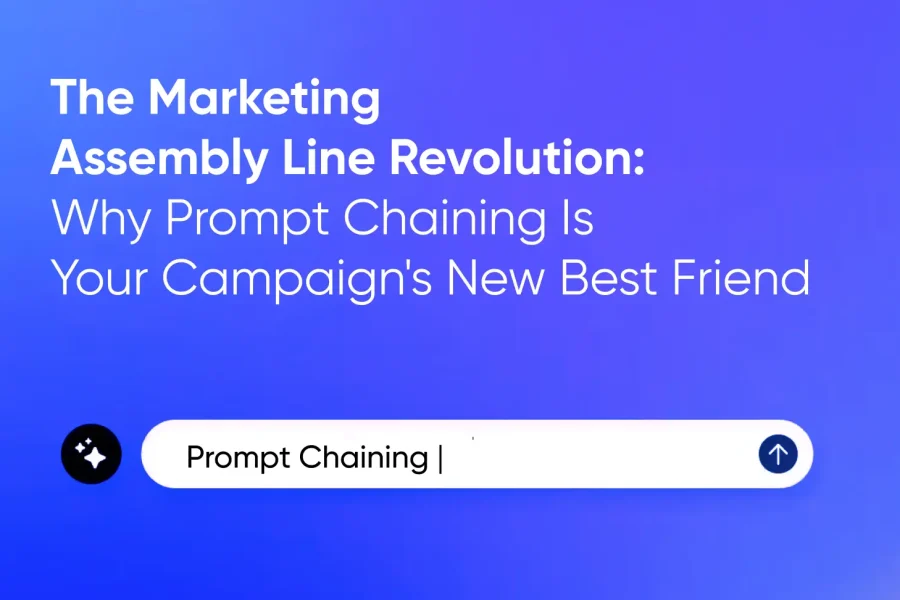Remember the last time your team launched a campaign under pressure?
You know the drill: creative brief gets passed around six different people, each adding their “quick feedback,” while the copywriter waits for design direction, the designer waits for asset approval, and meanwhile your launch date is breathing down your neck like an overeager sales manager.
If this sounds painfully familiar, you’re experiencing what 70% of business leaders identify as a core productivity drain: repetitive tasks that consume 45 minutes to 3 hours of an 8-hour workday.
In marketing, this translates to something even more costly campaign delays that make your competitors look like they have crystal balls.
Here’s where prompt chaining changes everything.
What Prompt Chaining Actually Means (Without the Tech Jargon)
Think of prompt chaining like Henry Ford’s assembly line, but for marketing campaigns. Instead of one worker trying to build an entire car, each station perfects one specific task before passing the work to the next station.
In marketing terms, prompt chaining breaks your complex campaign creation into sequential, AI-powered steps where each stage builds perfectly on the previous one. Your campaign brief automatically flows into audience research, which feeds into message development, which creates asset briefs, which generate creative concepts all with built-in quality gates to catch issues before they compound.
The magic isn’t just automation; it’s intelligent sequencing with validation checkpoints. Like having a brilliant campaign manager who never forgets a step, never misses a deadline, and always asks the right questions at the right time.
The Hidden Cost of Marketing’s “Telephone Game”
Before we dive into the solution, let’s acknowledge the real problem.
According to recent productivity research, over 50% of employees report being “relatively unproductive” at work, with task switching alone costing 40% of productivity.
In marketing, this manifests as what I call the “Campaign Telephone Game”:
- Monday: Creative director shares campaign vision in a team meeting
- Tuesday: Account manager translates this into a brief (with some creative interpretation)
- Wednesday: Copywriter interprets the brief (adding their own assumptions)
- Thursday: Designer interprets the copy (making educated guesses about visual direction)
- Friday: Client feedback requires starting over because original vision got lost in translation
Sound familiar?
Research shows that 94% of companies perform repetitive, time-consuming tasks that could be streamlined.
In marketing, these handoffs between team members and tools create endless opportunities for miscommunication and rework.
Meanwhile, your competitors using prompt chaining architecture are launching campaigns 60% faster while you’re still stuck in email chains clarifying the difference between “engaging” and “compelling” copy.
How Prompt Chaining Transforms Campaign Development
Let’s walk through a real example. Imagine you’re launching a new product feature.
Here’s how prompt chaining turns chaos into choreography:
Stage 1: Strategic Foundation
AI Agent analyzes your product data, competitor landscape, and historical campaign performance to create a comprehensive campaign foundation. No more starting with a blank page or recycling last quarter’s strategy.
Validation Gate: Does the strategic direction align with business objectives and market positioning?
Stage 2: Audience Intelligence
Using the strategic foundation, AI conducts deep audience research, identifies behavioral patterns, and creates detailed buyer personas with messaging hooks that actually resonate.
Validation Gate: Do audience insights support campaign strategy and reveal actionable messaging opportunities?
Stage 3: Message Architecture
The AI crafts core messaging, value propositions, and communication frameworks tailored to each audience segment, maintaining brand voice consistency.
Validation Gate: Does messaging hierarchy effectively communicate value and differentiate from competitors?
Stage 4: Creative Direction
Based on messaging architecture, AI generates creative concepts, visual directions, and asset specifications that bring strategy to life.
Validation Gate: Do creative concepts effectively execute message strategy and align with brand guidelines?
Stage 5: Asset Production
AI produces copy variations, design briefs, and content assets optimized for each channel and audience segment.
Validation Gate: Do assets meet quality standards and campaign requirements across all touchpoints?
The result?
What used to take 3-4 weeks of back-and-forth now happens in days, with built-in quality control that prevents the typical “oops, we missed something” moments that derail timelines.
The Business Case: Why Your CFO Will Love This
Let’s talk numbers that matter to the C-suite.
Marketing automation users report 80% more leads and 77% higher conversion rates
But here’s what’s really compelling about prompt chaining specifically:
- Time Compression: Automation can save employees 240 hours per year, but in marketing, prompt chaining’s sequential optimization can compress campaign development timelines by 60-70%.
- Error Reduction: Workflow automation improves accuracy by eliminating manual handoffs, while prompt chaining’s validation gates catch strategic misalignments before they become expensive mistakes.
- Consistency at Scale: 83% of marketing departments automate social media processes, 75% automate email marketing, but prompt chaining ensures brand and message consistency across all automated outputs.
- Resource Optimization: Instead of creative talent spending time on repetitive briefing and revision cycles, they focus on strategic thinking and creative innovation the work only humans can do.
Real-World Applications: Where Prompt Chaining Excels
- New Product Launches: From concept to campaign execution in days, not weeks. Perfect for competitive markets where timing determines market share.
- Seasonal Campaign Rollouts: Automatically adapt core campaigns for different regions, audiences, and channels while maintaining strategic coherence.
- Content Marketing Programs: Transform single content pieces into multi-format, multi-channel campaigns with consistent messaging and brand voice.
- Crisis Response: Rapidly develop coordinated response campaigns across channels with pre-approved messaging frameworks and brand guidelines.
- A/B Test Development: Generate multiple campaign variations systematically to identify optimal messaging and creative approaches.
When Prompt Chaining Isn’t the Right Choice
- Transparency time: prompt chaining isn’t a universal solution. Here’s when to consider alternatives:
- Highly Creative, Artistic Campaigns: If your campaign is more art than science, human creativity should lead. Prompt chaining works best for campaigns with clear strategic objectives.
- Simple, One-Off Executions: For quick social posts or simple email campaigns, prompt chaining might be overkill. Save it for complex, multi-stage initiatives.
- Undefined Strategic Direction: If you’re still figuring out what you want to say, start with strategic planning before implementing structured workflows.
- Brand-New Organizations: Without historical data and established brand voice, prompt chaining has less context to work with.
Getting Started: Your First Prompt Chain
Ready to test this architecture?
Start with your next product announcement campaign:
- Define Your Chain: Map out your current campaign development process and identify the 5-7 key stages
- Set Validation Gates: Determine what “good” looks like at each stage with specific criteria
- Start Simple: Begin with content marketing campaigns where mistakes are less costly
- Measure Everything: Track time savings, error reduction, and output quality compared to traditional processes
- Scale Gradually: Add complexity as your team becomes comfortable with the workflow
The Competitive Edge You Can’t Ignore
Here’s the reality:
69% of daily management tasks will be automated by 2024, according to Gartner.
Marketing teams that master prompt chaining now will have a significant first-mover advantage.
While competitors struggle with campaign coordination and timeline management, your team will be launching cohesive, strategic campaigns with the speed and precision of a Formula 1 pit crew.
The companies that figure out prompt chaining first won’t just save time they’ll capture market opportunities that slower-moving competitors miss entirely.
In marketing, timing often matters more than budget, and prompt chaining gives you time.
What’s Next: Building Your Architecture Stack
Prompt chaining provides the foundation, but it’s just the beginning.
In next blog, we’ll explore parallel processing architecture, what happens when you need to execute multiple campaign elements simultaneously without sacrificing quality or coordination.
Think of it as prompt chaining’s more ambitious sibling: instead of sequential perfection, you’ll discover how to orchestrate multiple AI agents working in parallel to compress timelines even further.
Because while prompt chaining solves the handoff problem, parallel processing solves the capacity problem.
And in today’s marketing environment, you need both.
Ready to implement prompt chaining in your marketing operations?
Explore our Agentic AI services or calculate your potential efficiency gains with our ROI calculator.
Missed the series introduction?
Read 👉 The Marketing AI Architecture Crisis: Why Your ‘AI Strategy’ Might Be Building on Quicksand to understand why architecture choice determines AI success.


